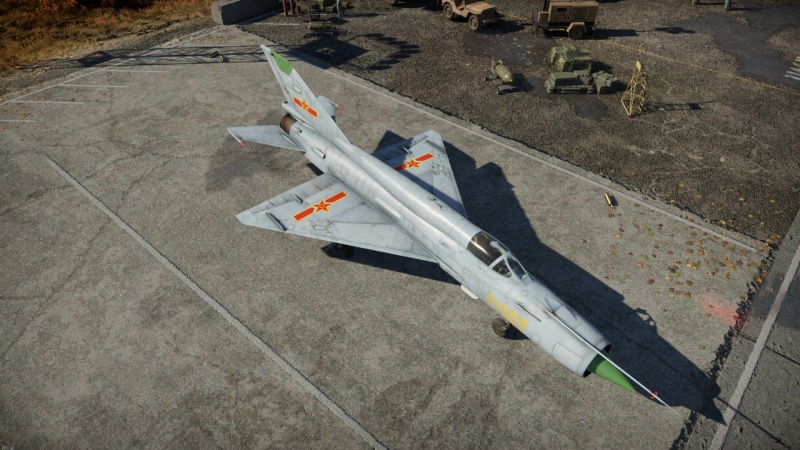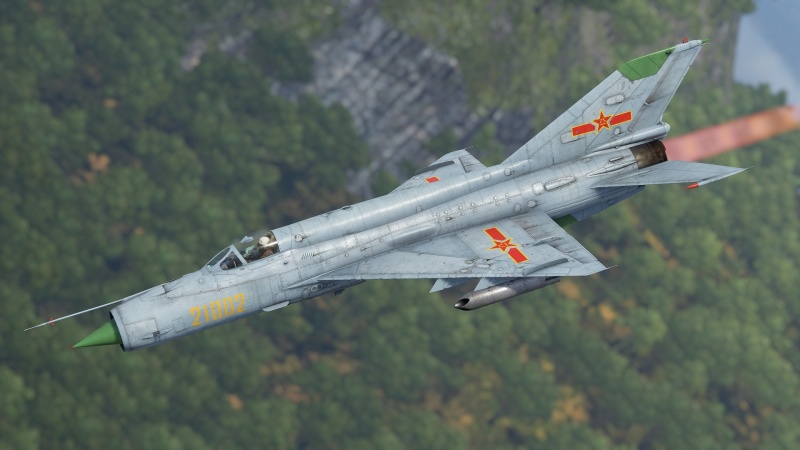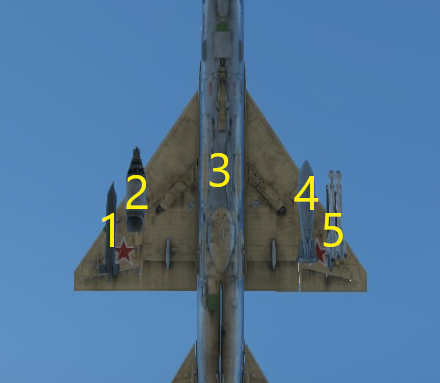J-7D
| This page is about the Chinese jet fighter J-7D. For other MiG-21 versions, see MiG-21 (Family). |
Contents
Description
The J-7D (Chinese: 歼-7D型歼击机, AKA J-7IIIA 歼-7IIIA; unified NATO codename: Fishcan) was an upgrade of the previous J-7C (J-7III), which was based on Egyptian MiG-21MFs with domestic avionics and HUD. The PLAAF obtained MiG-21MF aircraft from Egypt, and due to the slow progress of the J-8 development program and the need for interceptors to counter potential Soviet threats, there were plans to replace the J-8II series with a reverse-engineered variant. Although the development of the J-7D was successful and showed improved performance in some aspects, the J-8II program and the introduction of the Su-27SK Flanker-B (and its licensed CKD/SKD variant, J-11A) to the PLAAF limited the demand for the J-7D, resulting in only a few orders being placed to utilize the prebuilt airframes.
Introduced in Update "Apex Predators", the J-7D offers very similar performance to the late MiG-21 series but with a better engine and increased fuel capacity. While it lacks missiles for head-on/interception missions and large-calibre rockets like S-24s, its combat capabilities are still substantial with its IR AAMs and variety of Chinese ground-attack weaponries.
General info
Flight performance
Taking a look at J-7D, other than its default grey-tone camo and the PLAAF roundel onboard, the jet itself looks extremely similar to the late MiG-21 series with R-13F-300 engines. This is indeed true as J-7III series (C and D) were both based on MiG-21MFs exchanged from Egypt; in short, J-7D flies very similarly to the MiG-21MF in LSK (East German) service. The later variants of the Fishbed feature higher fuel capacity (the "spine" is filled with fuel tanks) and higher engine thrust, as well as featuring a new RP-22 radar; the J-7D exhibits all of the aforementioned upgrades. The lighter weight and higher thrust of the WP-13F1 engine also ensures a faster speed even against a MiG-21bis while having slightly better manoeuvrability as well; do remember that the J-7D is still an interceptor after all, so in most cases utilising its speed is more than enough to take out enemies at its tier. But do beware of light fighters or tailless delta-wing jets in one-on-one dogfights, it's better to quit the fight and wait for better chance to take them down in one pass.
| Characteristics | Max speed (km/h at 12,000 m) |
Max altitude (metres) |
Turn time (seconds) |
Rate of climb (metres/second) |
Take-off run (metres) | |||
|---|---|---|---|---|---|---|---|---|
| AB | RB | AB | RB | AB | RB | |||
| Stock | 2,348 | 2,323 | 26.9 | 27.9 | 143.2 | 134.3 | 750 | |
| Upgraded | 2,488 | 2,419 | 25.4 | 26.0 | 199.3 | 170.0 | ||
Details
| Features | |||||
|---|---|---|---|---|---|
| Combat flaps | Take-off flaps | Landing flaps | Air brakes | Arrestor gear | Drogue chute |
| X | ✓ | ✓ | ✓ | X | ✓ |
| Limits | ||||||
|---|---|---|---|---|---|---|
| Wings (km/h) | Gear (km/h) | Flaps (km/h) | Max Static G | |||
| Combat | Take-off | Landing | + | - | ||
| - | 500 | 450 | ~17 | ~7 | ||
| Optimal velocities (km/h) | |||
|---|---|---|---|
| Ailerons | Rudder | Elevators | Radiator |
| < 650 | < 600 | < 950 | - |
Engine performance
| Engine | Aircraft mass | |||||
|---|---|---|---|---|---|---|
| Engine name | Number | Basic mass | Wing loading (full fuel) | |||
| Shenyang Liming WP-13FI | 1 | 5,812 kg | 353 kg/m2 | |||
| Engine characteristics | Mass with fuel (no weapons load) | Max Gross Weight | ||||
| Weight (each) | Type | 9m fuel | 20m fuel | 30m fuel | ||
| 1,200 kg | Afterburning axial-flow turbojet | 6,501 kg | 7,297 kg | 8,108 kg | 9,635 kg | |
| Maximum engine thrust @ 0 m (RB/SB) | Thrust to weight ratio @ 0 m (WEP) | |||||
| Condition | 100% | WEP | 9m fuel | 20m fuel | 30m fuel | MGW |
| Stationary | 4,160 kgf | 6,751 kgf | 1.04 | 0.93 | 0.83 | 0.70 |
| Optimal | 4,283 kgf (1,365 km/h) |
7,411 kgf (1,365 km/h) |
1.14 | 1.02 | 0.91 | 0.77 |
Survivability and armour
Other than the airframe and aluminium alloy skin, the J-7D has no additional protection; any hits from enemy weapons are very likely to either severely damage the jet or take out the pilot straight away. However, an EFS system and self-sealing tanks are present onboard, giving it some chance to return to the airfield if it survives subsequent assaults from enemies.
Modifications and economy
Armaments
| Ballistic Computer | |||
|---|---|---|---|
| CCIP (Guns) | CCIP (Rockets) | CCIP (Bombs) | CCRP (Bombs) |
| |
|
|
|
Offensive armament
The J-7D is armed with:
- 1 x 23 mm Type 23-3 cannon, belly-mounted (200 rpg)
- 72 x countermeasures
Suspended armament
The J-7D can be outfitted with the following ordnance:
| 1 | 2 | 3 | 4 | 5 | ||
|---|---|---|---|---|---|---|
| 250 kg 250-3 bombs | 1 | 1 | 1 | 1 | ||
| 250 kg 250-4 bombs | 1 | 1 | 1 | 1 | ||
| 500 kg 500-3 bombs | 1 | 1 | ||||
| 500 kg 500-4 bombs | 1 | 1 | ||||
| Type 90-1 rockets | 7 | 7 | 7 | 7 | ||
| Type 130-2 rockets | 4 | 4 | 4 | 4 | ||
| PL-2 missiles | 1 | 1 | 1 | 1 | ||
| PL-5B missiles | 1 | 1 | 1 | 1 | ||
| PL-7 missiles | 1 | 1 | 1 | 1 | ||
| 490 l drop tanks | 1 | 1 | 1 | |||
| Maximum permissible weight imbalance: 570 kg | ||||||
| Default weapon presets | |
|---|---|
| |
To say the least, the loadout of the J-7D is very similar to its (technological) successor J-7E, as they share 5 out of the 6 loadouts. The only difference is the missiles it carries: instead of having already obsolete PL-2, it has PL-7 (reverse-engineered R.550 Magic 1 from Pakistan) at your disposal which players of French aircraft are very familiar with. In terms of A2A capabilities, J-7D does lack SARH missiles of any sort (R-3R, for example), but both IR-guided AAMs are among the best of their counterparts. For those who are familiar with the PL-5B's immersive thrust and overload even at distance, they can take down enemies from some distance as a safer approach to confronting masses of jets. Alternatively take PL-7 if players prefer hitting targets within 2.5 km, it might not be as powerful in higher tier where flares are abundant, it can still make short work of careless targets.
If players also decided to take on ground targets, it still has limited but sufficient options like 250/500 kg bombs and rockets of different calibre (90/130 mm). The ballistic computer also helps achieve precision hits depending on the playstyle and overall situation of the battlefield. Bring in bombs in case of columns of tanks within the blast radius, both types of bombs show enemies the importance of "social-distancing". While rockets are better for destroying SPAAs from above (since they don't have radar coverage above; given the skies are clear), for players who get used to the ballistics performance of rockets, it can still knock out even the heaviest MBTs with precision hits from 130 mm HEAT Type 90-1 rockets with overpressure.
Usage in battles
The J-7D is a slightly advanced version of MiG-21MF equivalent with HUD and built-in countermeasures, best used as a support fighter to more advanced jets or to hammer ground targets.
Air - Sudden Striker
For players who are already used to the MiG-21MF or its Soviet equivalents (SMT or later Bis), a bad news for J-7D is the lack of any head-on capable missiles (neither R-60M nor R-3R, due to the incapability to develop such missile until mid-1980s). Players will also find the radar as a welcome but not effective addition to the jet due to its already obsolete performance at its BR. But to say at least, J-7D performs identically to 2nd generation Fishbeds with slightly better engine output and overall better missile options. It has neither highly-manoeuvrable missiles like the R-60(MK) nor SARH missiles, but this will be compensated by two of the most powerful rear-aspect IR AAMs in game: PL-5B and PL-7 (R550 Magic 1). For players of the J-7E or J-8B, they will still be pleased by the immersive thrust of the missile and the rather high manoeuvrability at longer distance. For those who are used to French jets or A-5C, the PL-7 still retains identical performance to the Magic 1. Depending on the playstyle, players can either take the PL-5B for long-distance sudden strikes on unaware enemies or PL-7 for close distance combats within 2 km: it does have the chance to track onto most enemies at this tier given the flares won't distract the missile. A principle for delta jets like the J-7D is to never get into a dogfight unless in an 1-vs-1 situation. Due to the design of delta wings, the wing area of delta wings will certainly cause severe bleeding on speed after manoeuvres against enemy targets, which is extremely fatal to jets. It might be true that the lesser weight yet more powerful jet engine can compensate the manoeuvrability, but it is still suggested to use the J-7D as a support fighter and strike unaware enemies, and only go into gunfights if it has high likelihood to friendly-fire or if there's only one enemy left.
Ground - "Economical" Alternative
While the J-7D is known to be an interceptor, if players prefer a more economical jet while having the demand for air-defense capability, the J-7D can also be a capable alternative to the Q-5L or more air-defense-capable J-7E/J-8B. The ground attack loadout for the J-7E is identical to the J-7D's, thus 250/500 kg bombs and 90/130 mm rocket pods are always at the player's disposal. Due to its high tier and limited payload, it is best to utilize the J-7D as a high-altitude "striker" and use its sufficient climb rate to go high and hide from ground radars. Players can also take the time to see if there is any other attacker harassing the team and take them out (make sure to get onto their six for a lock). Since the limited payload hinders the jet's capability to cause severe losses to enemy team, pick the most high-value targets (i.e. those going for capture points or camping at vantage points) and sent them sky high with either bombs or rockets. Alternatively, picking off SPAAs with rockets is also viable but make sure to pull up before the jet hits low altitude (which the jet might not be able to recover from).
Pros and cons
Pros:
- Better engine thrust than most previous J-7/MiG-21 series thanks to the WP-13F1 engine
- Access to search radar
- Relatively better light rocket options than Soviet MiG-21MF/S series
- Devastating PL-5B or PL-7 missiles at its disposal
- Built-in countermeasures with 72 salvos, unlike its Soviet cousins
- Has full ballistic computer for cannon, rockets, and bombs; useful in ground attack
Cons:
- Bleeds excessive amounts of energy during turns, making it very tricky to retain energy in dogfights
- Engine overheats on most maps if left in WEP
- Poor radar performance with shorter range than common foes like F-14, F-4E
- Lacks all-aspect IR missiles and SARH missiles
- Below average pylon counts for its tier
History
By the time the Type 62 and subsequent J-7I/II series went into commission with the PLAAF in the late 1960s, the PLAAF was already seeking a new fighter for all-weather interception and to replace earlier jets in service. Although the J-8 program was also started around the same time, it was only until 1979 when J-7II was finalized and J-8I was passed for certification. This also called for a back-up for the J-8I series. During the late 1970s economy reform and increasing international arms trade with foreign countries, Chinese engineers visited countries with MiG-21MFs in service and took the design for future use; CATIC also exchanged some Soviet equipment from Egypt including MiG-23SM and MiG-21MF as the reverse-engineer subject for new interceptors.
The new J-7III started its development in March 1979 by CAC and after 5 years of repairing MiG-21MFs while building domestic prototypes, the J-7III took its first flight on 26th April 1984 and subsequent flight tests continued until 1988 when the first batches rolled off the production line. The reverse-engineered jet featured a new engine and a domestic JL-7 radar based from Type 317A radar from the failed Q-5 Yi (强-5乙, perhaps the very last torpedo bomber ever developed), but engine production issues hindered the further production of J-7III (now called J-7C under new designation) with only 17 of them built. Meanwhile, as the J-7III continued to be developed, CAC and GAIC worked on new electronics and countermeasure systems as well as a new WP-13F1 engine for the new jet. The new jet, developed in 1988, featured a new JL-7A radar capable of launching the latest PL-8 missiles, reverse-engineered Marconi Type 956 HUD, as well as Type 930-4 countermeasure system. J-7IIIA (now called J-7D) took its first flight in mid-1991 and joined the PLAAF in 1995.
Due to changes in combat doctrine, introduction of more advanced Su-27SK Flanker-B and J-7E, as well as J-8II series becoming combat-capable in 1990s and the successful development of Project No. 10 (J-10), the J-7D was deemed unnecessary and only 39 of them were built by 1999 as the placeholder for new jets; these jets made it into their first and only appearance in the National Day Parade of 1999, alongside with Flankers and air-refuel-capable J-8D.
The default livery of the J-7D represents No.21002 of the PLAAF, while the pre-order livery represents the test livery of the first J-7IIIA (J-7D) numbered 0151, now repainted into a blue-themed camouflaged and displayed in a square in Dazhou, Sichuan.
Media
- Skins
See also
External links
| Chengdu Aircraft Industry Group (中航工业成都飞机工业集团) | |
|---|---|
| Jet Fighters | |
| J-7 | J-7II* · J-7D · J-7E |
| J-10 | J-10A |
| JF-17 | JF-17** |
| Drones | Wing Loong I |
| *Unlicensed and reverse-engineered version of the MiG-21. | |
| **Jointly developed and built by Chengdu Aircraft Industry Group and Pakistan Aeronautical Complex. | |
| See Also | Mikoyan-Gurevich Design Bureau · Pakistan Aeronautical Complex |
| China jet aircraft | |
|---|---|
| Fighters | J-2 · J-4 · J-6A · J-7II · J-7D · J-7E · J-8B · J-8F · J-10A · J-11 · J-11A |
| Strike aircraft | Q-5 early · Q-5A · Q-5L · JH-7A |
| Bombers | H-5 |
| France | ␗Mirage 2000-5Ei |
| USA | ␗F-84G-21-RE · ␗F-84G-31-RE · ␗F-86F-30 · ␗F-86F-40 · ␗F-100A · ␗F-100F · ␗F-104A · ␗F-104G · ␗F-5A · ␗F-5E · ␗F-16A MLU |
| USSR | ␗MiG-9 · ␗MiG-9 (l) |
| North Korea | Shenyang F-5 |
| Pakistan | A-5C · JF-17 |
| China premium aircraft | |
|---|---|
| Fighters | ␗A6M2 · D.510C · ␗F-47N-25-RE · H-81A-2 · Hawk III · ␗Ki-45 hei/tei · ␗Ki-84 ko · ␗P-51C-11-NT |
| Jet fighters | Shenyang F-5 · J-7D |
| Strike aircraft | A-5C · ␗F-84G-31-RE |







